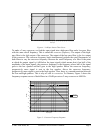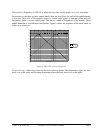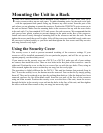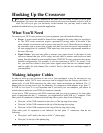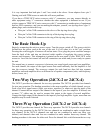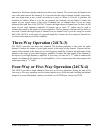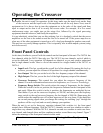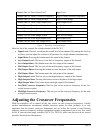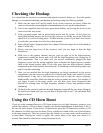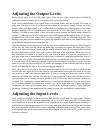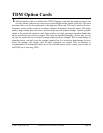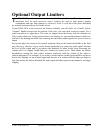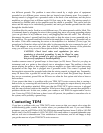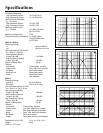
© 2003 TDM Audio, Inc. Electronic Crossover Owner’s Manual Page 16
Checking the Hookup
It is critical that the crossover is connected and adjusted correctly before use. To avoid speaker
damage, we recommend checking your hookup and settings using the following method.
1. Make sure the input level and all output levels on the crossover are down. Adjust the
crossover frequencies according the recommendations of your speaker manufacturer.
2. Turn on the amplifiers and raise their gains about halfway up (leaving the levels on the
crossover all the way down).
3. Feed a program signal such as pre-recorded music into the system. At this point you
should hear nothing because the levels at the crossover are all the way down. Adjust the
signal level so you are feeding about -20 dBm into the system. If you don’t have meters
to verify this, just set the level a bit lower than normal.
4. Start with the highest frequency band for a channel. Raise the output level of that band up
about ¼ of the way.
5. Slowly raise the input level of the crossover until you just begin to hear the high
frequencies.
6. Walk over to the speaker cabinets and put your ear right up to the high-frequency
components (usually the horns) and verify that the high frequencies are coming out of
these components. This is to make sure you haven’t accidentally plugged the high
frequency output into the wrong amplifier input or hooked the high frequency speaker
cable to the wrong speaker input. If you have more than one high frequency speaker
component on the same channel, check them all. If something is not hooked up right, stop
and fix it before continuing.
7. Once you are satisfied that the high frequencies are being reproduced by the correct
components, raise the crossover output level a little bit and listen to the sound. If you are
inexperienced, it may take a little practice to get used to what the various frequency
bands usually sound like. Make sure that the crossover points are correct. For example, if
you forgot to press in the range switch, you will hear some lower frequencies that
shouldn’t be coming from the high frequency speakers. Correct any problems before
continuing.
8. Go back to the crossover and turn the high frequency output all the way down. Bring up
the next lowest band until you can just hear it. Repeat steps 6 and 7 for each band from
highest to lowest.
Using the CD Horn Boost
If you are using constant directivity (CD) horn designs for your high frequency speakers, your
system may require a CD horn boost. Consult your speaker manufacturer to determine if this is
the case for your system. If you need a CD horn boost, press the CD horn boost switches in for
the channels on which you need the boost. These switches are found on the rear of the unit next
to the input connectors. They are recessed into the chassis so you may need a small screwdriver
to press them. Pressing the switch in applies the correct boost to the input near which it is
located. This should be done before setting the output levels.



